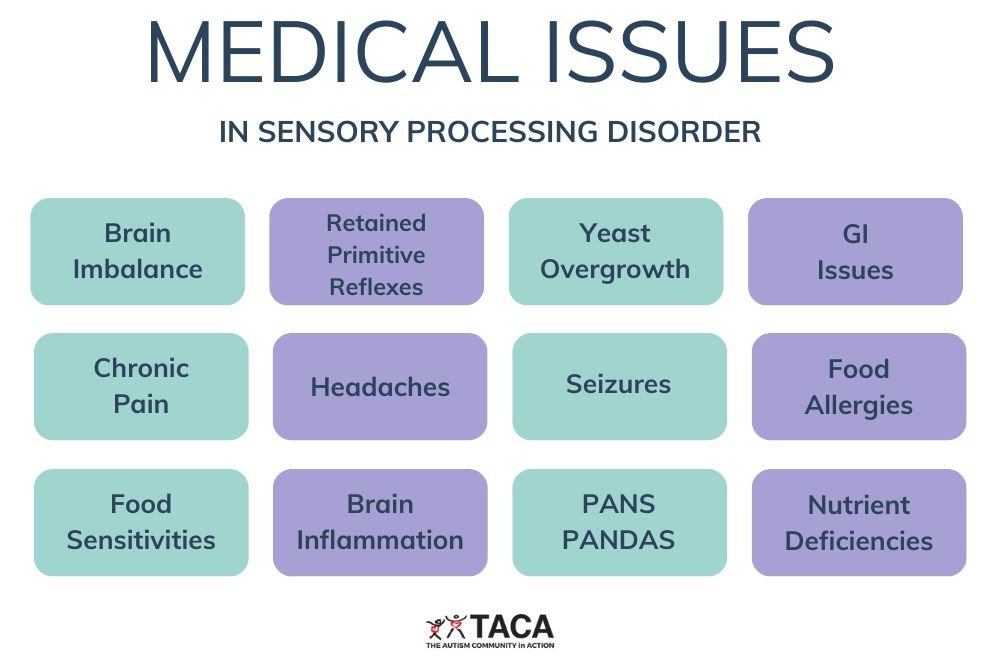Effective Management of Sensory Processing Disorder in Autism

All contents of this resource were created for informational purposes only and are not intended to be a substitute for professional advice, diagnosis, or treatment. Always seek the advice of your physician, therapist, or other qualified health providers with any questions or concerns you may have.
Let’s explore a range of therapeutic and medical interventions tailored to meet the unique needs of individuals facing sensory challenges. Understanding and treating SPD in autism is crucial for improving sensory integration and boosting overall quality of life. This article dives into the specifics of occupational therapy, sensory integration therapy, and the importance of creating sensory-friendly environments. Additionally, we examine the significant impact of underlying medical conditions on SPD and provide practical strategies.
Therapeutic Interventions and Support
Explore a variety of therapeutic approaches and supportive strategies designed to help individuals with autism manage sensory processing disorder effectively.
Occupational Therapy
Sensory Diets: Tailored activities designed by occupational therapists (OTs) to help the individual manage their sensory needs throughout the day.
Skill Development: Assist in developing coping strategies for sensory challenges that interfere with daily activities.
Sensory Integration Therapy
Customized Interventions: Specific exercises and routines to help the individual respond more effectively to sensory stimuli.
Therapeutic Equipment: Swings, trampolines, resistance tunnels, and other tools that provide sensory feedback.
Environment Adjustments
Sensory-Friendly Spaces: Create areas at home and school that minimize sensory overload or can provide needed sensory input.
Adaptive Tools: Provide noise-canceling headphones, specialized lights, and other modifications to reduce sensory triggers.

Medical Issues Contributing to Sensory Processing Disorder
Understanding the underlying medical conditions that can worsen or contribute to Sensory Processing Disorder (SPD) is crucial for developing effective treatment plans. This section explores several medical issues that can influence sensory processing in individuals, particularly those with autism.
Brain Imbalance
Neurological Foundation: SPD can stem from an imbalance in brain function, where the processing of sensory information is disrupted.
Impact on Sensory Processing: This imbalance can lead to difficulties in perceiving and responding to sensory input, causing over- or under-sensitivity to stimuli.
Retained Primitive Reflexes
Developmental Concerns: Primitive reflexes are automatic movements directed from the brain that should be inhibited as a child grows. Retention beyond the typical age can indicate developmental delays affecting sensory integration.
Connection to SPD: These retained reflexes can interfere with motor control, posture, and sensory processing, contributing to the challenges seen in SPD.
Yeast Overgrowth
Common in Autism: Yeast overgrowth is often linked with a compromised immune system or a diet high in sugars and carbohydrates.
Impact on Behavior and Sensory Responses: Yeast can cause or worsen behavioral issues and sensory sensitivities due to the toxins released, which affect neurological function.
Gastrointestinal Issues
Prevalence of GI Distress: Conditions like constipation, GERD, IBS, and diarrhea are common in autism populations.
Sensory and Emotional Impact: Chronic discomfort and pain from GI issues can heighten sensitivity to external stimuli, making sensory symptoms more pronounced.
Pain and Increased Sensory Sensitivity
Chronic Pain: Conditions that cause chronic pain, such as joint hypermobility, constipation, or headaches, can make individuals more susceptible to sensory overload.
Feedback Loop: Persistent pain can lead to a heightened state of sensory alertness, where even mild stimuli become overwhelming.
Seizures
Neurological Disruptions: Seizure activity, including subclinical abnormal discharges, can affect sensory processing.
Post-Seizure Sensitivity: After a seizure, individuals may experience increased sensitivity to sensory inputs, affecting their tolerance levels.
Food Allergies and Sensitivities
Immune Response: Allergic reactions to foods can cause inflammation, which may impact brain function and sensory processing.
Behavioral and Sensory Changes: Food allergies and sensitivities can lead to changes in behavior, mood, and sensory responses, often complicating SPD symptoms.
Infections Causing Brain Inflammation
Neuroinflammation: Certain infections can lead to inflammation in the brain, affecting neurological function and sensory processing.
PANS/PANDAS: Conditions like PANS/PANDAS directly link infections, histamine, and stress triggers, to changes in neuropsychiatric behavior and sensory sensitivities.
Vitamin and Mineral Deficiencies
Essential Nutrients: Vitamin and mineral deficiencies, such as magnesium, vitamin D, and the B vitamins, can affect neurological health and sensory processing.
Impact on SPD: These nutrients are crucial for nerve function and brain health; lacking them can exacerbate or contribute to sensory processing challenges.
Practical Strategies for Parents and Caregivers
Discover key strategies that can be done by parents to create better sensory management for their children at home and school.
Home-Based Activities
Sensory Activities: Create sensory bins, hang an indoor swing, or buy a mini trampoline to give your child ways to receive sensory input.
Daily Routines: Incorporate sensory activities that can help manage sensitivities.
Safe Spaces: Designate a quiet area in the home where the individual can retreat when feeling overwhelmed.
Educational Supports
IEP Involvement: Work with schools to include specific sensory needs in the Individualized Education Plan.
Teacher Training: Educate school staff on the importance of sensory accommodations in the learning environment.
Sensory Tools: The classroom should be equipped with items like fidget toys, seat cushions, and visual aids.
Conclusion
The treatment of Sensory Processing Disorder in individuals with autism requires a comprehensive approach that includes both therapeutic interventions and addressing medical issues. By creating supportive environments and utilizing tailored therapeutic techniques, individuals with SPD can achieve improved sensory integration and a better quality of life. These efforts, combined with ongoing support from parents, caregivers, and educators, are essential in helping those with sensory issues navigate their daily lives more effectively.




